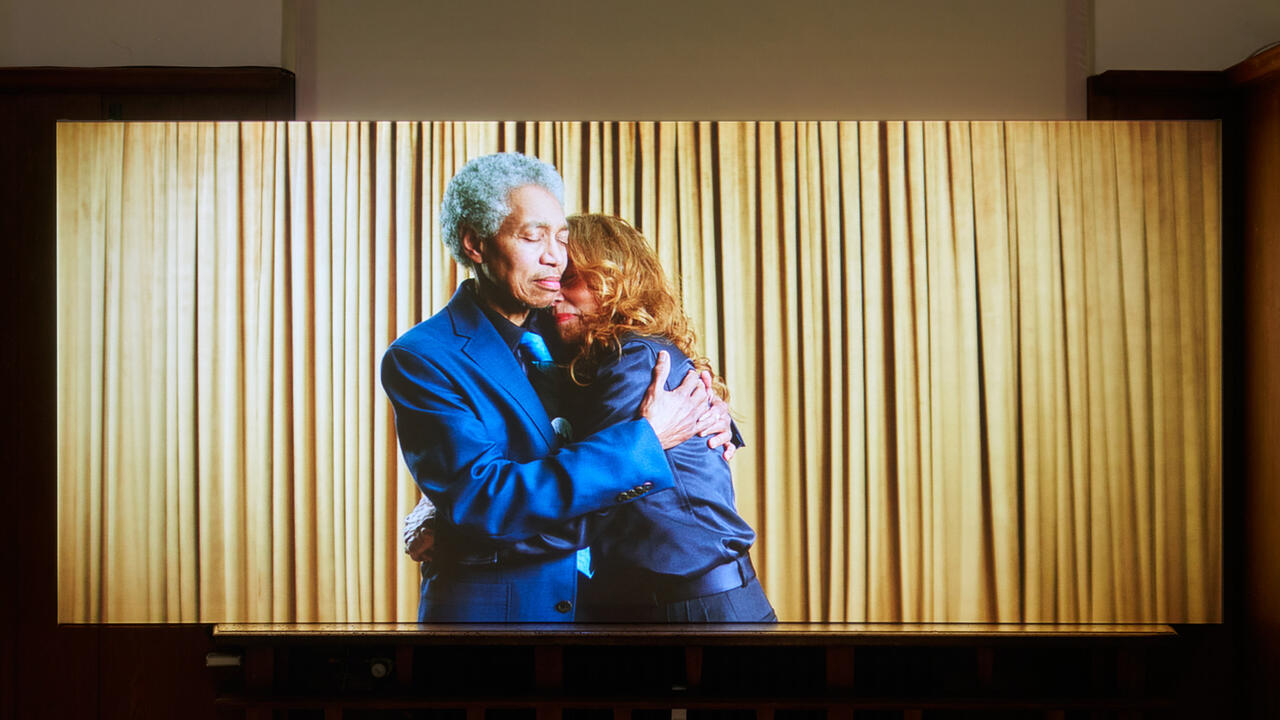Carol Rama
Galerie Isabella Bortolozzi, Berlin, Germany
Galerie Isabella Bortolozzi, Berlin, Germany

This exhibition of works by Italian artist Carol Rama spans an artistic career of over 60 years, from the early 1940s to the early 2000s. In a gallery with a stable of artists whose average age must be less than half that of Rama, who is 90, this exhibition serves to introduce the artist to a younger generation largely unfamiliar with her work, despite her receiving the Golden Lion at the 2003 Venice Biennial and a retrospective of her work at Fondazione Sandretto Re Rebaudengo, Turin, in 2004.
Rama’s work seems both ahead of and outside of its time. Its broad stylistic range takes in overtly sexual, expressive watercolours made in the late 1930s and early ‘40s and returned to in the ‘80s; abstract paintings in the ‘50s; ‘Bricolages’ from the ‘60s; and reliefs incorporating rubber inner tubes or pieces of leather from the ‘70s onwards. Self-taught, she describes her work as the result of the personal tragedies she experienced when she was young: her mother suffered from mental illness and her father committed suicide after going bankrupt. Painting was an escape from her anguish and became a world in which she could exercise her extreme need for freedom: ‘I didn’t have any painters as masters, the sense of sin is my master.’ This explicitly autobiographical approach, like that of other artists of her time such as Louise Bourgeois or Maria Lassnig, together with her explicitly female lexicon of imagery, kept her work (as theirs) aloof from the mainstream and largely underappreciated for much of her life.
The controversial nature of Rama’s work (her first exhibition in 1945 was shut down by the authorities in Turin before it even opened) is immediately apparent in the first room of the exhibition. The dark atmosphere of the wood-panelled chamber, a decidedly unconventional gallery space, is a perfect fit for the psychosexual fantasies on display. Watercolours in heavy ornate frames display all the eroticism underscored with violence that typifies Rama’s earliest works. In Dorina (1940), a serpent emerges from between the spread legs of a seated nymph, while Heretical (1944) shows a prostrate bear on a white slab being penetrated from behind, a thick red tongue emerging from his mouth like a phallic continuation. These are like dark perversions of Grimm’s fairy tales, laced with bestiality and deformation, where the promise of gratification is always tinged with affliction.
A thickly swabbed oil painting from the same period, I Tarocchi (Tarot Cards, 1948), in which two women with heavy lidded, black-hole eyes and yellow ochre skin observe the cards lain out before them, speaks more of melancholy, however. Rama subsequently developed the flat pictorial space and lozenges of colour seen here into the abstractions she began making under the auspices of the Movimento Arte Concreta in the 1950s. The uncontrollable sexuality of her watercolours was suppressed in what must be read as an act of self-censorship: ‘I felt that I had to wean myself from that excess of freedom for which I had been criticized.’ This exhibition skips the period of lyrical abstraction, taking up again in the early sixties with Black Oval (1961), in which a great spattering of lumpy matter is daubed over with black paint. In these works – christened ‘Bricolages’ by Rama’s long-term friend and collaborator, avant-garde poet Edoardo Sanguineti – surfaces are corrosive, blistered or bubbling, with clusters of dolls’ eyes or teeth clinging to them like subconscious matter returning from the depths.
Having fallen out with the intellectuals and returned to being a transgressive anomaly, Rama went on to make some of her best work in the 1970s. These pieces incorporate bicycle inner tubes, sliced open and flattened out to ripple on the surface of the canvas, suggestively punctuated by prominent metal valves, or laid out in strips, their patched surfaces like ragged old skin pocked with trauma and decay. Not incidentally, her father had owned a bicycle factory before going bankrupt. Two recent paintings, Punto Zero (Point Zero, 2003) and Senza attenuati (Without Extenuations, 2003) elaborate on the inherent sexuality (and sadomasochistic overtones) of this material, pairing rubber curves with a stylized patterning of disembodied penises, or tongues.
Rama was rescued from relative obscurity at the end of the 1970s by curator and critic Lea Vergine, who included her in the influential 1980 exhibition ‘The Other Half of the Avant-Garde,’ leading her to return to the explicit, expressive watercolours she had abandoned for over 30 years. Several of these from the last two decades are included here, and show a vivid continuation and expansion of themes and imagery from the early periods. Why is it repeatedly the fate of these vigorous, uncompromising female artists to disappear and require continual rediscovery? As Lucy Lippard put it when describing Lee Lozano, another such case: ‘She was always a figure who slipped between stools.’























